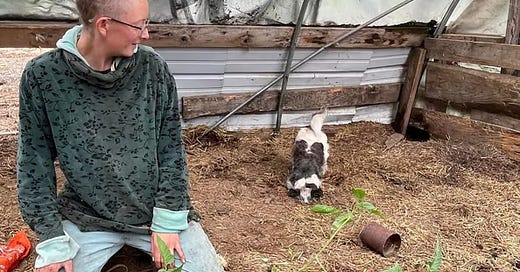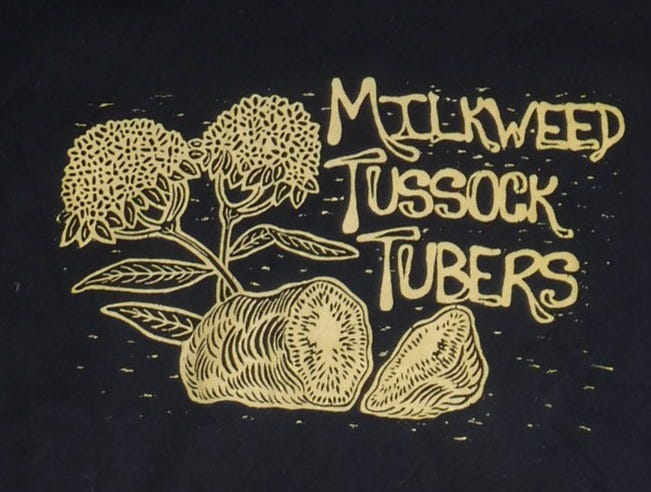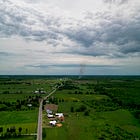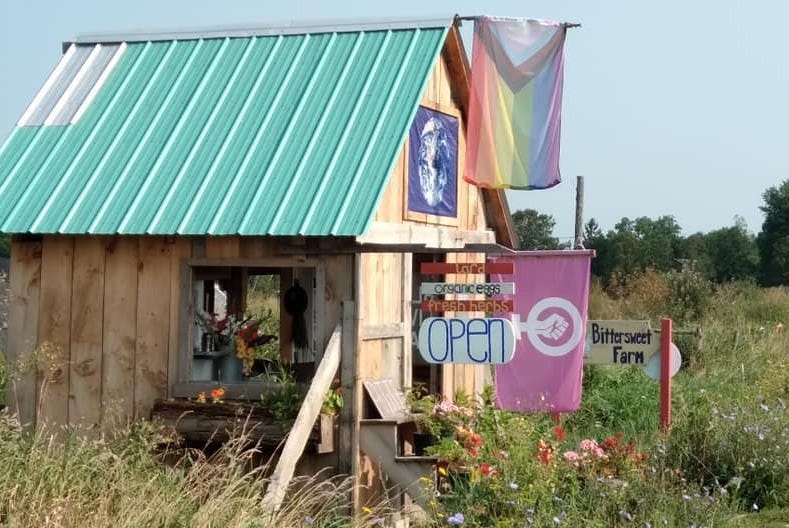I realized the other day that there are quite a few new subscribers to this newsletter, and we don’t have an extensive bio, or a detailed welcome letter. I thought, then, that an extra newsletter describing our history, our present, and our dreams for the future would be appropriate.
Depending on what document or website you read you’ll see I describe the farm something like this: “The Bittersweet-Milkweed Collaborative is a queer, small-scale adventure in community-oriented regenerative agriculture, emphasizing intersectional rejuvenation in our everyday work.” We’re located in the place called by some the St Lawrence River Valley in New York. The original Bittersweet Farm was founded in 1999 by my parents, Ann and Brian Bennett. Working with 111.5 acres of land that was, for many years prior to our moving in, farmed as a small dairy with corn and hayfields, my parents started out with basic, organic practices, emphasizing diversity and soil health to the best of their abilities. Within a brief period of time, they were able to observe – and respond to – the positive changes occurring as they welcomed the returning wild flora and fauna. They began what was arguably the first CSA, or Community Supported Agricultural Program, in the area, selling chickens, garlic and eggs. By 2016, the farm included Highland cattle, St Croix-Barbados sheep, Tamworth-Large Black pigs, heritage chickens, one food forest and one food forest-in-the-making, four greenhouses and one market-style garden. Products were given away or sold from the farm and at local farmers markets. Classes were hosted and volunteers visited on a regular basis. My mother managed the greenhouses, herbs, seed keeping, bookkeeping and value-added products, as well as acting as the point person for community outreach. My father worked with the animals, the market garden, the equipment and the hay.
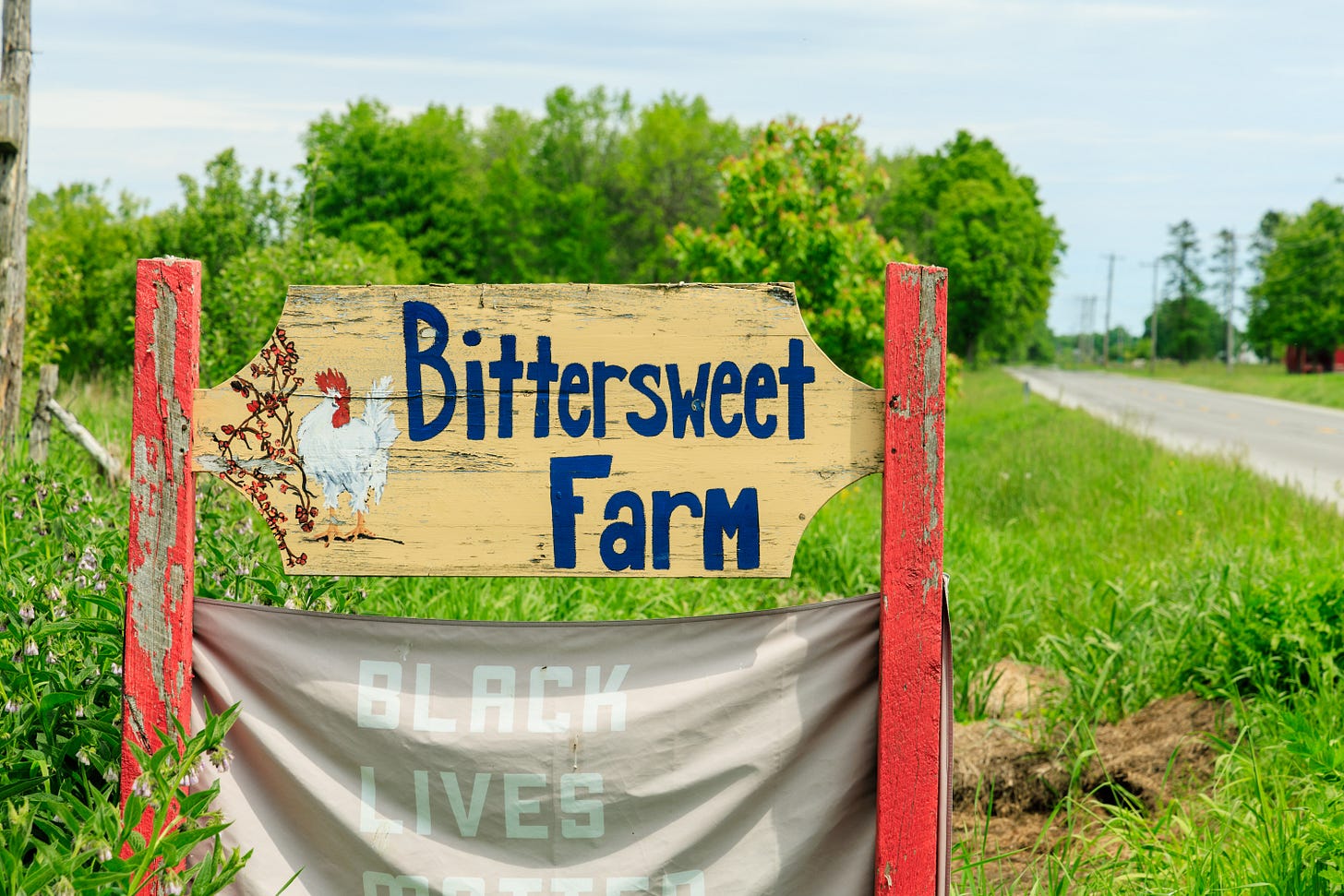
There was, occasionally, the question of whether or not the kids would take over the farm someday. Truth be told, I never intended to. How I wound up here is an entire other tale; needless to say, however, I found my way back to the farm fairly soon after college.
On December 18, 2016, I sat down and drew the logo for what would become my small-scale, regenerative potato farm, Milkweed Tussock Tubers. I purchased a house a quarter mile from Bittersweet Farm and began working learning from the land with whom I’d spent 16 years developing a relationship. I started sourcing the oddest, rarest spuds from whom I could learn, eventually growing as many as 22 varieties at a time. I reached out to Ken White, the farmer at Saranac Valley Farms. He taught me everything he could about becoming a certified seed grower, what different diseases look like, and where to find seedstock and supplies. He then sold me his precious potato planter, whom I call Penny – she was Ken’s grandfather’s planter, and she’s still going strong. The seed potatoes gained a loyal following, and I began the work of restoring our region’s rarest, home-developed potatoes, the Ashworths and the CDF9s, later throwing in a few endangered sunchoke varieties for fun.
I also decided what I didn’t want to do. I didn’t want to weed (too much pressure and not something I find enjoyable), transport manure and compost from the barn all the way to different gardens (freakin’ heavy), and I don’t feel super comfortable around tractors (I avoid them if I can).
This meant I needed to implement specific practices for my well-being and the well-being of the farm. Two rounds of heavy hay mulch and no or low-till gardening, with light discing in the Spring, replaced weeding, increased organic matter and carbon sequestration, reduced flooding and drought difficulties, and increased biodiversity. Rotationally grazing the Highland cattle and the chickens of Bittersweet Farm onto the potato patches reduced the need to manually spread manure or compost. And tractors will someday be replaced by my ox Galadryal. She and her sisters, Emma and Fern, were my first serious attempt at training oxen. Fern would rather be a milk cow and pouts whenever I get the yoke out. Emma is feisty and we still struggle with obedience. Galadryal, however, enjoys the work and has done consistently well, despite my spotty efforts.
Enter December of 2022. I woke with a startling realization – that my parents, in their efforts to scale down, work less, and eat bacon and sausage – were going to butcher several pigs, one of them being my favorite, my (five-year-old) baby, Bluebelle. And the only way I could keep her alive was to take over management of Bittersweet Farm.
(I will confirm now that making bold, life-altering decisions to save one specific non-human is a pattern in my life, yes. I am aware that though it is an admirable, powerful, amazing character trait, some might question my sense of self-preservation. Fear not! I have, in the past year or two, discovered that self-preservation is a thing, and I am attempting to grasp the concept, while still giving my life over to others on a regular, if not daily, basis.)
Three days later I broke my right leg.
And that’s how the Bittersweet-Milkweed Collaborative began! I’m still not that sure about the name, but I wanted to honor our roots while respecting my potato farm. Both operations are now one, for all intents and purposes, and I do sometimes still go by Milkweed Tussock Tubers. It’s a cool freaking name.
‘Collaborative,’ however – that was very intentional. One reason I never anticipated being a farmer is that I knew by age eight you couldn’t farm alone (by alone, I mean without other humans). I’m not saying folks don’t, but I don’t recommend it. And I genuinely never believed I’d find someone with whom to farm (the jury’s still out on that, in case anyone wants to fill the empty slot.) But what I can do is find other farmers, friends, and community members who, although not living with me or working with the same land, could share the responsibilities, joys and burdens of small-scale and regenerative agriculture. We can swap seeds and grow beets in exchange for garlic, help each other round up cows, build fences, and lean on each other for skills that we don’t both have, like writing, painting, website development, or public relations.
And that’s where we’re at. Right now, our present is actively creating our future. The whole farm is currently 113.5 acres, and includes hayfields, pastures, forests, hedgerows, swamps and shrubland. We’ve still got all the animals, gardens, potatoes, seeds, and greenhouses. At last count, there were over 85 bird species, nine amphibian species, ten reptilian species, and countless insects, flora, mammals and more. The farm has become a sanctuary for at least a dozen threatened or endangered species, and the ecological diversity and health here explodes into the protected wetlands bordering us, as well as neighboring farms and backyards.
In August, we fully launched ourselves into the mindset shift of the gift economy, seeking to give away food, share our spaces and skills and develop deeper relationships, in ways ever more intentional and deliberate. Though our roots were always grounded in giving and sharing, this is different. It’s changing things for the better. We’re actively collaborating with several farms, friends, and family members to do all the aforementioned activities, and I’m developing ways to connect with other growers who may not be ready to share labor or responsibilities, but still want to chat or share tools.
Labor this Winter is mostly Brian and I, as we don’t currently have funds to pay employees. We’ve had paid employees almost year-round for the past three years, however, and will need more assistance. One hope is the intentional collaborative efforts. Volunteers are here every weekend, many of them from area universities, and I love developing those relationships with people a bit closer to my age than my father. Certain practices are changing with my management. I follow, as closely as I can, what the trees, land and animals tell me. More and more butchering is happening on-site, animal births are on a new, healthier schedule, I pushed back seed starting by a full month, and I’m slowly seeking to bring more humans onto the farm in a more permanent way. I’m seeking a roommate (Description), and with time, we’ll renovate certain buildings to include living quarters. The farm has always been meant to provide sanctuary. It’s not the right fit for everyone, but it’s what we must do. Financial sanctuary for those without funds to purchase food. Ecological sanctuary for extirpated and at-risk species. Social sanctuary for those threatened by public policy and cultural oppression.
I’m proud of where we are. It has been, at times, gut-wrenchingly depressing. Loss has been uncountable. But we’re still here, still looking forward to each day, and still eager to learn. I’m still at my most passionate when I see an unfamiliar bird species in the maples and can learn their life history, how they fit in on the farm, and how I can serve them and their friends. I think that’s how I feel about a lot of it, really. What about you? Tell me your history. How can our lives fit together? How can we serve each other and those around us? How can the farm’s status as a sanctuary be extended to everyone we touch, everyone who comes to us? How can we create our future together, now?
Love,
Kia-Beth
Pronouns: they/zi (Read more about personal pronouns here)

